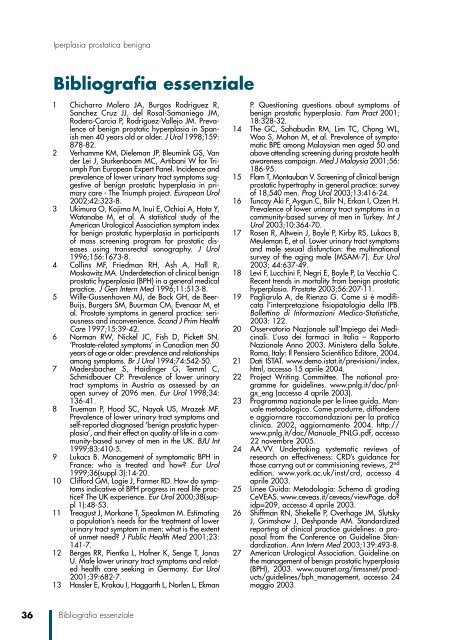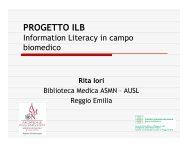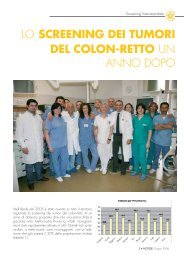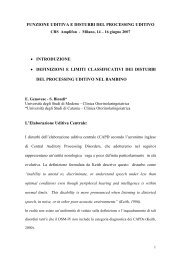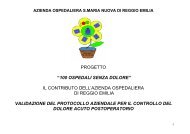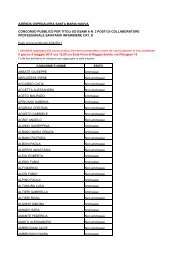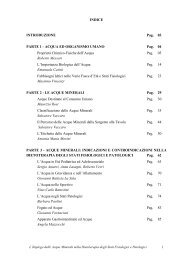versione pdf - Sistema Nazionale Linee Guida
versione pdf - Sistema Nazionale Linee Guida
versione pdf - Sistema Nazionale Linee Guida
You also want an ePaper? Increase the reach of your titles
YUMPU automatically turns print PDFs into web optimized ePapers that Google loves.
Iperplasia prostatica benignaBibliografia essenziale1 Chicharro Molero JA, Burgos Rodriguez R,Sanchez Cruz JJ, del Rosal-Samaniego JM,Rodero-Carcia P, Rodriguez-Vallejo JM. Prevalenceof benign prostatic hyperplasia in Spanishmen 40 years old or older. J Urol 1998;159:878-82.2 Verhamme KM, Dieleman JP, Bleumink GS, Vander Lei J, Sturkenboom MC, Artibani W for TriumphPan European Expert Panel. Incidence andprevalence of lower urinary tract symptoms suggestiveof benign prostatic hyperplasia in primarycare - The Triumph project. European Urol2002;42:323-8.3 Ukimura O, Kojima M, Inui E, Ochiai A, Hata Y,Watanabe M, et al. A statistical study of theAmerican Urological Association symptom indexfor benign prostatic hyperplasia in participantsof mass screening program for prostatic diseasesusing transrectal sonography. J Urol1996;156:1673-8.4 Collins MF, Friedman RH, Ash A, Hall R,Moskowitz MA. Underdetection of clinical benignprostatic hyperplasia (BPH) in a general medicalpractice. J Gen Intern Med 1996;11:513-8.5 Wille-Gussenhoven MJ, de Bock GH, de Beer-Buijs, Burgers SM, Buurman CM, Evenaar M, etal. Prostate symptoms in general practice: seriousnessand inconvenience. Scand J Prim HealthCare 1997;15:39-42.6 Norman RW, Nickel JC, Fish D, Pickett SN.‘Prostate-related symptoms’ in Canadian men 50years of age or older: prevalence and relationshipsamong symptoms. Br J Urol 1994;74:542-50.7 Madersbacher S, Haidinger G, Temml C,Schmidbauer CP. Prevalence of lower urinarytract symptoms in Austria as assessed by anopen survey of 2096 men. Eur Urol 1998;34:136-41.8 Trueman P, Hood SC, Nayak US, Mrazek MF.Prevalence of lower urinary tract symptoms andself-reported diagnosed ‘benign prostatic hyperplasia’,and their effect on quality of life in a community-basedsurvey of men in the UK. BJU Int1999;83:410-5.9 Lukacs B. Management of symptomatic BPH inFrance: who is treated and how? Eur Urol1999;36(suppl 3):14-20.10 Clifford GM, Logie J, Farmer RD. How do symptomsindicative of BPH progress in real life practice?The UK experience. Eur Urol 2000;38(suppl1):48-53.11 Treagust J, Morkane T, Speakman M. Estimatinga population’s needs for the treatment of lowerurinary tract symptom in men: what is the extentof unmet need? J Public Health Med 2001;23:141-7.12 Berges RR, Pientka L, Hofner K, Senge T, JonasU. Male lower urinary tract symptoms and relatedhealth care seeking in Germany. Eur Urol2001;39:682-7.13 Hassler E, Krakau I, Haggarth L, Norlen L, EkmanP. Questioning questions about symptoms ofbenign prostatic hyperplasia. Fam Pract 2001;18:328-32.14 The GC, Sahabudin RM, Lim TC, Chong WL,Woo S, Mohan M, et al. Prevalence of symptomaticBPE among Malaysian men aged 50 andabove attending screening during prostate healthawareness campaign. Med J Malaysia 2001;56:186-95.15 Flam T, Montauban V. Screening of clinical benignprostatic hypertrophy in general practice: surveyof 18,540 men. Prog Urol 2003;13:416-24.16 Tuncay Aki F, Aygun C, Bilir N, Erkan I, Ozen H.Prevalence of lower urinary tract symptoms in acommunity-based survey of men in Turkey. Int JUrol 2003;10:364-70.17 Rosen R, Altwein J, Boyle P, Kirby RS, Lukacs B,Meuleman E, et al. Lower urinary tract symptomsand male sexual disfunction: the multinationalsurvey of the aging male (MSAM-7). Eur Urol2003; 44:637-49.18 Levi F, Lucchini F, Negri E, Boyle P, La Vecchia C.Recent trends in mortality from benign prostatichyperplasia. Prostate 2003;56:207-11.19 Pagliarulo A, de Rienzo G. Come si è modificatal’interpretazione fisiopatologia della IPB.Bollettino di Informazioni Medico-Statistiche,2003: 122.20 Osservatorio <strong>Nazionale</strong> sull’Impiego dei Medicinali.L’uso dei farmaci in Italia – Rapporto<strong>Nazionale</strong> Anno 2003. Ministero della Salute.Roma, Italy: Il Pensiero Scientifico Editore, 2004.21 Dati ISTAT. www.demo.istat.it/previsioni/index.html, accesso 15 aprile 2004.22 Project Writing Committee. The national programmefor guidelines. www.pnlg.it/doc/pnlgx_eng(accesso 4 aprile 2003).23 Programma nazionale per le linee guida. Manualemetodologico. Come produrre, diffonderee aggiornare raccomandazioni per la praticaclinica. 2002, aggiornamento 2004. http://www.pnlg.it/doc/Manuale_PNLG.<strong>pdf</strong>, accesso22 novembre 2005.24 AA.VV. Undertaking systematic reviews ofresearch on effectiveness: CRD’s guidance forthose carryng out or commisioning reviews, 2 ndedition. www.york.ac.uk/inst/crd, accesso 4aprile 2003.25 <strong>Linee</strong> <strong>Guida</strong>: Metodologia: Schema di gradingCeVEAS. www.ceveas.it/ceveas/viewPage. do?idp=209, accesso 4 aprile 2003.26 Shiffman RN, Shekelle P, Overhage JM, SlutskyJ, Grimshaw J, Deshpande AM. Standardizedreporting of clinical practice guidelines: a proposalfrom the Conference on Guideline Standardization.Ann Intern Med 2003;139:493-8.27 American Urological Association. Guideline onthe management of benign prostatic hyperplasia(BPH), 2003. www.auanet.org/timssnet/products/guidelines/bph_management,accesso 24maggio 2003.36Bibliografia essenziale


